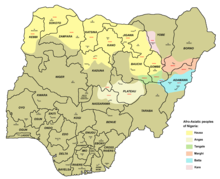Margi language
| Margi | |
|---|---|
| Native to | Nigeria |
| Region | Adamawa, Borno, Gombe, Taraba and Yobe State |
| Ethnicity | |
Native speakers | 5,000,000 |
Afro-Asiatic
| |
Writing system | Latin, Arabic (Ajami) |
| Language codes | |
| ISO 639-3 | mrt |
| Glottolog | marg1265 |
 Ethnic territories of the Marghi-speaking people in Nigeria (pinkish red) | |
Margi, also known as Marghi and Marghi Central, is a Chadic language (a branch of Afroasiatic) spoken in Nigeria, Cameroon, and Chad. It is perhaps the best described of the Biu–Mandara branch of that family. Marghi South language and Putai are closely related and sometimes considered dialects of Margi.
There are several kinds of Marghi language, including Madube, Izge, Lassa, Gulak, Damboa, Mulgwai, Uba and Sukur.
Every kind of these languages were spoken different type of the language and were from different places.
Phonology[]
Vowels[]
Margi is noted for having a vertical vowel system, with only two phonemic vowels, /ɨ/ and /a/, in native vocabulary. (Loan words also distinguish /ɛ/ and /o/.)
Consonants[]
Margi has a large consonant inventory, with a number of labialised consonants and typologically infrequent speech sounds such as a labiodental flap. Hoffmann (1963) describes 84 consonantal phonemes, a very large number compared to that of most languages. This system, with a great number of non-click consonants, compares to that of the Caucasian language Ubykh, having the largest inventory of any language without clicks. However, Hoffmann's list of consonants includes all sequences of consonant clusters occurring in onsets in the language. Many of these clusters have since been analysed as sequences, such as /pt/ and /bz/.[1] If labialized consonants are counted separately, there are 66 consonants that remain in the analysis, and 54 if it is interpreted as a /Cw/ sequence.
| Labial | Dental | Alveolar | Lateral | Post- alveolar |
Palatal | Velar | Labio- velar |
Glottal | |
|---|---|---|---|---|---|---|---|---|---|
| Nasal | m mʷ | n | ɲ | ŋ | ŋʷ | ||||
| Glottalized | ɓ̰ ɓ̰ʷ | ɗ̰ | j̰ | w̰ | |||||
| Prenasalized | mp | nt ntʷ | nts ntsʷ | ntʃ | ɲc | ŋk | ŋkʷ | ||
| mb mbʷ | nd | ndz | ndʒ | ɲɟ | ŋɡ | ŋɡʷ | |||
| Oral occlusive |
p pʷ | t tʷ | ts | tʃ | c | k | kʷ | ʔ | |
| b bʷ | d | dz | dʒ | ɟ | ɡ | ɡʷ | |||
| Fricative | f fʷ | s sʷ | ɬ ɬʷ | ʃ | [ç] | x | ʍ | ||
| v vʷ | z | ɮ | ʒ | [ʝ] | ɣ | ||||
| Approximant | l | j | w | ||||||
| Vibrant | ⱱ | r |
[ç] and [ʝ] are palatalised allophones of /x/ and /ɣ/, the latter of which is closer to an approximant [ɰ].[2] The closely related language Bura is similar but has a palatalised lateral series as well. /ⱱ/ is used in mimesis rather than in lexical vocabulary. The glottalised consonants /ɓ̰ ɓ̰ʷ ɗ̰/ have been described as either creaky voiced or implosive; according to Maddieson, they are evidently both, as in Hausa.[3]
The sequences that Hoffmann included in his consonant inventory are all labial–coronal:
- ps [fs], pɬ, pç [fç], pt, pts, ptʃ, mpt, mpts, mptʃ, bz [vz], bɮ, (bʝ [vʝ]), bd, bdz, bdʒ, mbd, mbdz, mbdʒ, ɓ̰ɗ̰, mn[4]
See also[]
- Marghi South
- Marghi West
References[]
- ^ Ladefoged, Peter; Maddieson, Ian (1996). The Sounds of the World's Languages. Oxford: Blackwell. p. 344. ISBN 978-0-631-19815-4. Labial coronal consonants are excedingly rare in the languages the world.
- ^ Ladefoged, Peter; Maddieson, Ian (1996). The Sounds of the World's Languages. Oxford: Blackwell. p. 165. ISBN 978-0-631-19815-4.
- ^ Ladefoged, Peter; Maddieson, Ian (1996). The Sounds of the World's Languages. Oxford: Blackwell. p. 85. ISBN 978-0-631-19815-4.
- ^ There may be a few others, such as pɬ~mɬ, mʃ~mtʃ.
External links[]
Further reading[]
- Hoffmann, C. 1963. A Grammar of the Margi Language. Oxford University Press for International African Institute, London.
- Maddieson, I. 1987. "The Margi vowel system and labiocoronals." Studies in African Linguistics, vol. 18, No. 3, Dec. 1987.
- Biu-Mandara languages
- Languages of Nigeria
- Vertical vowel systems
- Biu-Mandara language stubs
- Nigeria stubs
